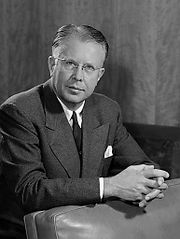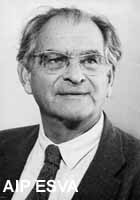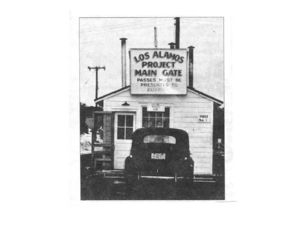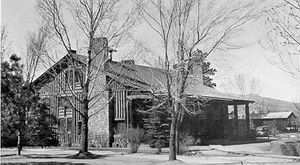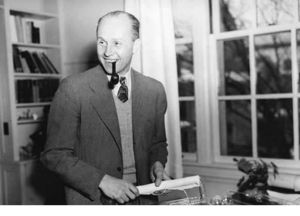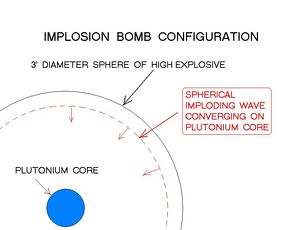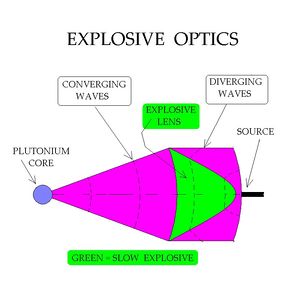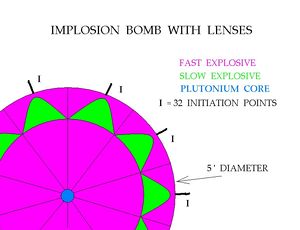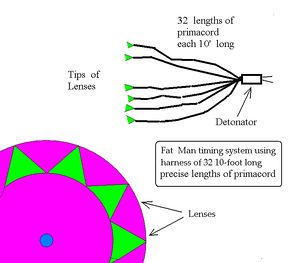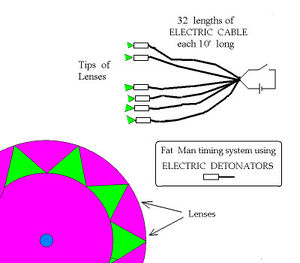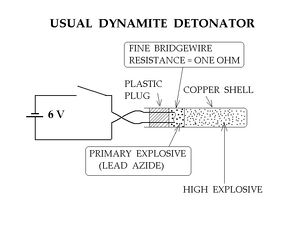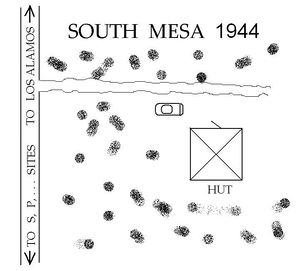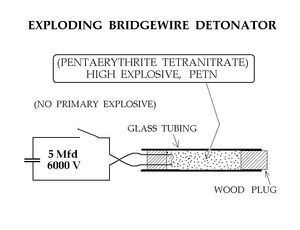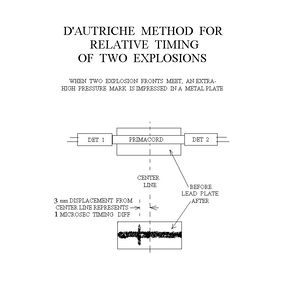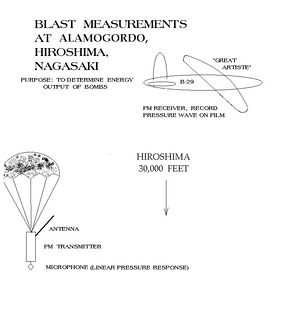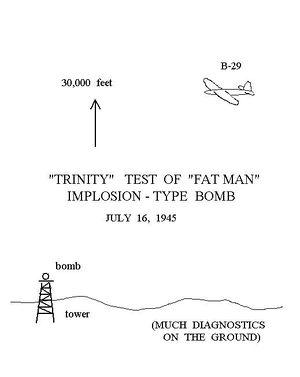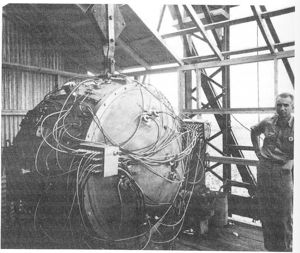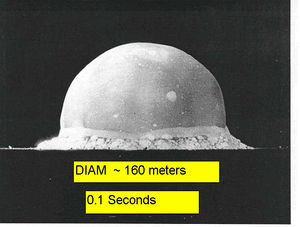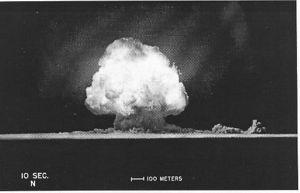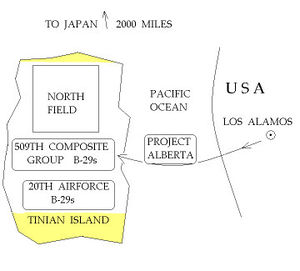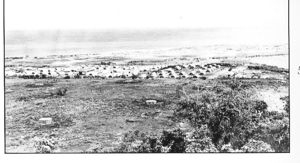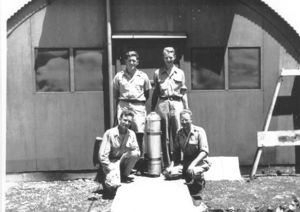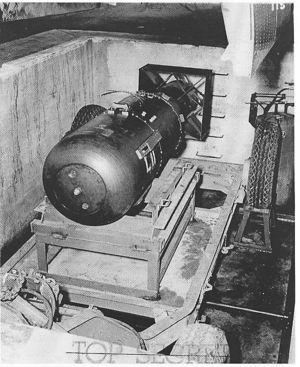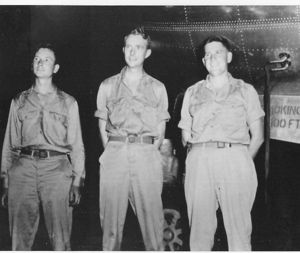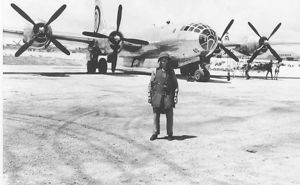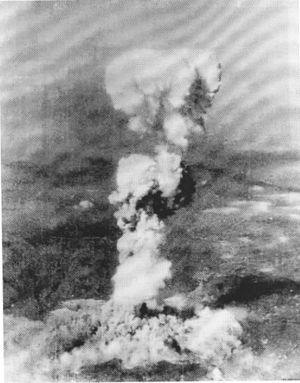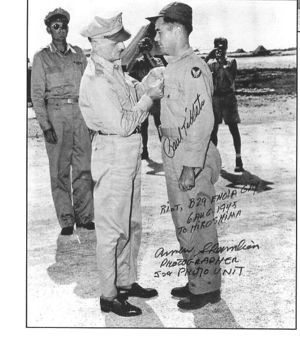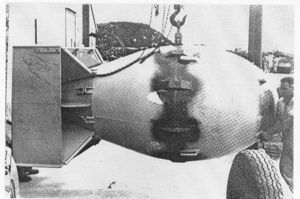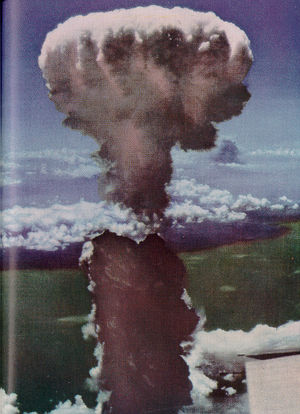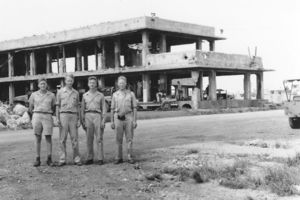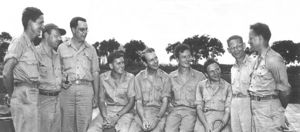First-Hand:Adventures at Wartime Los Alamos
Adventures at Wartime Los Alamos
Contributors: Lawrence Johnston, Professor of Physics, Emeritus, University of Idaho. Submitted on his behalf by the IEEE History Center Staff. Invited by Los Alamos Laboratory, Dr. Johnston gave this presentation on 9 August 2006.
This article will discuss three major topics. First about how we experienced life in wartime Los Alamos. Second, the work we did on the Fat Man Implosion type of bomb, and third, the three wartime bomb events: the Trinity Test of the Fat Man bomb, and the job that took us to the Tinian Pacific base, and the delivery missions of the bombs to Japan-- Hiroshima and Nagasaki.
For more on Johnston and his career, see the Lawrence Johnston oral history.
Life at Wartime Los Alamos
When I say "we" I mean Luis Alvarez and me. Of course there were others involved. I was just out of Berkeley as a physics major when the War in Europe started (I was born in 1918), and I hitched the start of my career to this fascinating man, Alvarez.
It is interesting that Alvarez in turn considered himself to be a disciple of Ernest Lawrence, now regarded as the founder of the "Big Science" trend during and after the War. Lawrence had a big hand in establishing and staffing the MIT radar lab, the Metalurgical Lab in Chicago, and Los Alamos.
As the war and technology went forward, Lawrence followed the progress of each Lab, and which lab most critically needed the help of particular scientists. Thus in early 1944 Lawrence decided that the now critical work at Los Alamos on the Fat man bomb needed the insights and ideas of Luis Alvarez; and Alvarez brought me.
Now about wartime Los Alamos living: Was it burdensome living in such an isolated environment? It may have been for some people with a liking for urban civilization, but for us, a young couple with a one-year old, it was an adventure. To us, it was more like living in a wilderness resort. On a weekend, you could take scenic hikes where the beauty started right at your back door. And we could see the pine forest starting right outside our kitchen window. Here is the kind of 4-plex apartment building we lived in (below).
Here are a few of my outstanding memories:
Steak night each week, at the cafeteria. A great chef. Meat was under wartime rationing, but no ration coupons were needed at the cafeteria.
On a hike, seeing a tree blown to kindling wood by lightning. Lightning at Los Alamos? Tell me about it! This was poignant, because just the day before the talk we experienced the fiercest lightning storm any of us had ever seen. Drenching rain and frequent lightning and hail. They said later there was 1.9 inches of rain, in less than an hour.
The Easter 1945 sunrise service outdoors. Jim Roberts, a Physics professor from Northwestern University brought the inspiring message of Jesus' resurrection.
Here is an interesting anecdote. When you were expecting a new member of the family, you went to the housing office and put up a card on the bulletin board. Accordingly when Geraldine Alvarez was expecting, they placed a card on the board applying for a larger apartment for the Alvarez family. At the next meeting of the town council, the wife of a well-known Austrian physicist came and complained that they were allowing those Spanish American workers named "Alvarez" to live in the prime housing of the site. Alvarez was a very good friend of this woman's husband, and they both got a big kick out of the incident. However, a subsequent conversation with Geraldine Alvarez herself in September 2006 indicates this story is not true, but she says there were complaints from the other occupants of the apartment building. Since we lived in the apartment just below the Alvarez’s, that leaves two families that may have complained.
Another incident-- I got a speeding ticket from one of the military police, and appeared before a court of 3 townspeople. I was fined $5 by the presiding judge, a very likeable Victor Weisskopf. He was one of the prime theorists there. More on that occasion.
Going back to my arrival at Los Alamos, I got off the train at Lamy, May 8, 1944. My wife and baby would arrive 2 weeks later. I was met by Alvarez and Kistiakowsky. We drove to The Hill in an army sedan, chaufeured by an army woman, a WAC. On the way they briefed me on the situation they faced. The Implosion bomb, the "Fat Man" had recently been given very high priority at the Lab, and Kistiakowsky had been brought in to head up a new Explosives Division. Alvarez had been there a few weeks, as his chief troubleshooter.
We stopped at the Santa Fe office to get me properly registered. Dorothy McKibbin gave me a white numbered badge to wear, and a pass card which indicated that I had a Q clearance, which meant I could be told anything in the Manhattan Project. It occurs to me that one reason for having both Alvarez and Kistiakowsky with me was to certify my identity with Dorothy, before she gave me the credentials for Los Alamos.
I found Kistiakowsky's office and he and Alvarez were soon telling me about the status of the Fat Man implosion bomb, and their problems with it.
Work on the Fatman Implosion Type Bomb
The idea of the Implosion bomb is to have an almost critical plutonium sphere and make it go supercritical by compressing the metal so all the Pu atoms get closer together. The compression is done by surrounding the metal with a large sphere of high explosive. To uniformly compress the metal, the explosive sphere is imploded, that is, a spherical wave of detonation starts at the outside of the sphere, and converges inward to compress the central plutonium ball.
This imploding wave is a very unnatural thing to accomplish, since most wavefronts go outward from the starting point, like the ripples when you throw a pebble in a pond. It takes a special optical system to make a converging wave out of a diverging one. A great deal of Los Alamos talent went into solving this problem.
The theoreticians and explosives people decided they would need to produce the converging wave in a piecemeal fashion, and then join up the partial waves further in to make a complete converging spherical wave. A very ambitious undertaking.
So they conceived of the surface of the explosive sphere as divided up into 32 areas, like the patches on a soccer ball, and they would make 32 separate optical systems to feed a converging explosive wavelet into each such area.
The usual way to do this with an ordinary light optical system would be to use a glass lens (right).
Light travels more slowly in glass than in air, so the central parts of the wavefront get delayed more than the edges. This transforms an outward-going diverging wave into a converging one.
So the explosives experts invented an explosive lens that would perform the same job, assuming that explosive waves obeyed the same optical laws of propagation. They made their explosive lenses out of a slow-propagating explosive.
Here is the same optical system, in the explosives regime (below).
So when 32 of these explosive lens sectors were assembled around the inner sphere, they could produce wavelets that would join up to make the required large converging wave.
Parenthetically, I would like to pay tribute to the skill and courage of those men who made those lenses and other explosive components of the bomb, out at S site. They first poured molton explosives into roughly shaped molds, and then machined the molded blocks into the precise shapes needed to fit together in the bomb assembly. I picture all this casting and machining to be precarious work, on explosive blocks of 50 to 100 pounds. Any slipup could have been lethal. I have not heard of any such accidents in the explosives fabrication program. You always wondered when you heard a big boom coming from several miles South of town.
All that is then needed is a way of starting the tips of all those 32 lenses at exactly the same time, so each lens system contributes its timely matching sector of the spherical imploding wave. When I arrived on the scene, the way of doing this was the way an explosives man would think of: Do it with explosives. They would use a harness of 32 10' long pieces of Primacord, a kind of explosive cord that is filled with a very fast high explosive. You could simply transfer an explosion from here to there, by joining the two places with a length of primacord.
This system of timing the lenses resulted in a scatter of lens timing events in the tens of microseconds, which was not nearly good enough for the requirement, that all the lenses should initiate within a tenth of a microsecond. This scatter was due to slight variations in the propagation speed of the wave in the primacord, and perhaps even the bending pattern of each cord. What was their solution? To try to get DuPont to make better primacord!
When Alvarez heard of this problem with the primacord timing, he suggested to Kistiakowsky that instead of 32 lengths of primacord, they should use 32 lengths of electric cable, each ending in an electric detonator. The speed of electric signals is 30,000 times faster than the speed in primacord. (There's a 6-volt battery to set them all off) But Kistiakowsky smiled and told him that the problem is that electric detonators have a long time delay of milliseconds before the full explosion starts.
Here's a usual dynamite blasting detonator, about a quarter inch in diameter (right). A 6-volt signal makes a tiny bridge wire glow red hot, and that starts a primary explosive burning, and that burning rapidly accelerates into a detonation, which starts the high explosive at the end.
Alvarez then came up with his celebrated idea that instead of burning that bridgewire with 6 volts, the wire could be made to explode by applying a much higher voltage - maybe 6000 volts. This small explosion might be able to start a high explosive directly, with no primary explosive and very little time delay.
So soon after I appeared in Kistiakowsky's office that first morning, they asked me to try out this idea for an ultra-fast electric detonator. It didn't take long to get something started, in those days, with all the services and supply storerooms available on the Hill, and the lack of red tape. I assumed that there was now plenty of red tape at Los Alamos, but nobody clapped. My conjecture was amply fulfilled when I later went thru the process of collecting my travel expenses. Within two days I was the sole proprietor of South Mesa, which was then a sagebrush covered few acres of territory. South Mesa is now densely built up. Most of the Tech area is now on South Mesa.
I had a government automobile, a 15x15 foot hutment delivered and erected, an electric generator, a work bench, a set of hand tools, a surplus high voltage power supply, an assortment of high-voltage capacitors, a box of 25 Dupont electric blasting caps, some lengths of glass tubing from the Chemistry Storeroom, and a 100' roll of primacord. If only I had thought to get some ear plugs, to protect my ears! But we were in a hurry.
My first experiment out on South Mesa violated most of the safety rules in the book. I did not have any such book, and I probably wouldn't have stopped to read it anyway. But I imagine one rule would have said "Never play with blasting caps, and never, never try to take them apart to see what's inside." As an aside, one of our young daughter's favorite toys was a box of those discarded yellow cardboard tubes in which the detonators came.
I took one of those blasting caps out of the box, pulled it out of its yellow cardboard tube, and straightened out the folded-up wires. I examined the copper shell critically, and noticed that where the wires went into the shell, some of the thin copper shell projected. It couldn't hurt to work on that, could it? So I used a pair of long-nosed pliers to grab that thin shell, and gently twisted it. The shell split open a bit, and when I twisted some more I noticed that the plug with the wires was loosening. It couldn't hurt to wiggle the plug out of the shell, could it?
So soon I was holding the wires, with a free plug on the end of them, and I saw that there was a fine bridgewire soldered to the stubby wires projecting through the plug. And I still had all my fingers, and both eyes. (I could easily have been wearing safety glasses!)
To construct the new detonator, I cut off a 2" length of glass tubing, and inserted the plug with bridgewire into one end. It fit nicely, so I glued it in place with DeKhotinsky cement. Now I was ready to add the high explosive, so I cut off a hunk of that primacord, and slit it open to get some PETN, that sensitive high explosive white powder I was told about; I poured it into the open end of the glass tube. I closed the system by pushing a wooden plug into the open end, and the new detonator was ready to try.
I poked it outside the door of the hutment, with the long wires inside. I started up the generator and charged up the capacitor to 6000 volts, and using an insulated screwdriver as a switch, touched the second wire of the new detonator to its terminal. Blam! It must have worked, and with no primary explosives to slow it down! There were glass fragments stuck in the outside of the door . Wow!
I jumped in the car and drove to Kistiakowsky's office, and yelled "It worked!" Kistiakowsky looked up and said what worked? When I told them what I had done, Alvarez was an instant believer, but Kistiakowsky said it might have been a low-order explosion. How long did it take for the explosion to get going? Parenthetically, this occasion is probably when I got the speeding ticket.
So to answer that question, I spent several days setting up an oscilloscope with a polaroid camera in a way to show the time delay, as an electronics person would do it-- the delay between the firing voltage spike and the arrival of the explosion along a short piece of primacord. When I got things working, I had a polaroid picture showing there was less than 2 microseconds delay. Again I jumped in the car and to Kistiakowsky's office. I put the picture on his desk, but he scarcely looked at it. He said, "This picture convinces you and Alvarez, and maybe it does me, but my explosives experts will only believe in results using purely explosives methods."
So he told us of a simple experiment we could do, which would show how closely the timing of two detonators compared, and that, after all, was what was needed for the bomb.
The two detonators to be timed are connected to opposite ends of a short piece of primacord. A lead plate is taped to the primacord, and a line is inscribed halfway between the two detonators. If the two detonate at exactly the same time, the two explosive waves in the primacord will meet in the middle, and produce an extra-high pressure mark in the plate. If one of the detonators is a little late, the waves will meet closer to that detonator, and the mark will indicate the relative timing. I made the assembly and ran the wires into the hutment, where the power supply was. Further reflection reminds me that this was assembled on a wooden 2x4, and that the wood was shattered in the explosion. I fired it, and then went outside and found the lead plate, about ten feet away from ground zero, under a bush. the mark was plain to see, indicating that the difference was about one microsecond, not bad for the first try. I grabbed the plate and drove in to show it to Kistiakowsky and Alvarez.
This time Kistiakowsky was convinced, and soon South Mesa was buzzing with testing and manufacturing of Exploding Bridgewire Detonators. Indian women were brought in from nearby pueblos to do the assembling and loading, and SED soldiers were in charge. Those women got real good at soldering the bridgewires on the entrance plugs and loading the explosives. The “solder” we used was Wood’s metal, melting at 70 degrees C. This was to avoid overheating the wires in the plastic plug, especially since we found that the detonator worked best if the bridge wire was laid flat against the end of the plug. Wood’s metal: 50%Bi, 25%Pb, 12.5%Sn, 12.5% Cd. Probably by weight. Soon all the Implosion tests on the Hill were using our exploding bridgewire detonators. It is interesting that when the time came in 1944 to patent the EBW detonator, Alvarez said that the patent should be in my name only, since I had done all the work. He could have taken the view that I was only the technician who carried out his ideas. Patent 3,040,660 was granted in 1962. (SED "Special Engineering Detachment" soldiers were young men who had been drafted into the army, who had special skills, such as electronics or chemistry. Los Alamos requested their services. These soldiers seemed happy to be doing things at Los Alamos, rather than fighting on foreign soil.)
By that time the engineers were designing the configuration of the final military weapon, the bomb that could be loaded into an airplane and dropped, and they adapted our detonators to that design. We were now merely consultants. So I felt free to join Alvarez in a new venture he had taken on.
Three Wartime Bomb Events
By April 1945 the Germans were a nearly defeated foe, and it was getting obvious that Japan would be the target of our bombs. Tinian Island in the Marianas was being rapidly made into a huge airbase from which B29 bombers of the 20th Airforce were systematically devastating the Japanese cities, and Los Alamos established "Project Alberta" or just “Project A" on Tinian, to assemble our bombs there for delivery to Japan.
Colonel Tibbets had established the "509th Composite group" of fifteen B29s and trained crews to deliver these bombs. The B29 was a new bomber, the first to be pressurized for high altitude flights. The Pacific theater was their first operational use. The 509th B29s were modified for our purpose, especially the bomb bays, to take the new shaped bombs, and those crews practiced their aim by flying over Japan and dropping bombs shaped like Little Boy and Fat Man. These placebo bombs were nevertheless loaded with tons of high explosive, so they did have some impact when they went off.
The new venture started when Alvarez asked Oppenheimer if there was any job where he was needed to go to Tinian, for Project Alberta. He really wanted to be in on the action. Oppie said there was one part that had not yet been covered: The military always wants reports when new weapons are used, reports on their effectiveness. He asked Alvarez to devise a way to measure the energy output of the bombs, when they went off over Japan. Alvarez asked if he could have his own B29 bomber, as part of the bombing mission, to make those measurements, and Oppie said he could probably arrange that.
So Alvarez came up with the following plan: As a measure of the bomb's energy, he would record the air pressure wave generated by the explosion. In talking to theorists, they told him that the energy of that source could be figured from the shape and duration of the shock wave, even if the wave were recorded at 30,000 feet elevation above the source. Here is how he planned to make the measurements (below).
The pressure wave will be received by this special microphone, hanging from a parachute in open air. It will telemeter the data by an FM radio channel to a receiver in our B29, where the pressure signal will be recorded on movie film. This system will be made in triplicate, i. e. three parachutes and three microphones, in case any of the three channels fails to function.
So Alvarez recruited a crew to build and man this new system, on very short notice. He got me, then Harold Agnew and Bernard Waldman, and several very capable SED soldiers. (Agnew later served as the director of Los Alamos.)
For the microphone Alvarez co-opted a system developed at Cal Tech by Wolfgang Panofsky. This included the FM telemetering transmitter, and the FM receiver to go inside the plane. He assigned to me the job of making the electronic recording equipment to go inside the plane, to produce the record on 16mm movie film. We used all the wonderful facilities of the lab-- the electronics people to build my oscilloscope design, and the optical people to procure and modify the movie cameras. Bernard Waldman prepared to use a Fastax movie camera to film the explosions directly, in slow motion.
When we heard that there was going to be a test firing of the Fat Man bomb, the Trinity Test, Alvarez decided that this would be a great opportunity for our crew to go thru a dress rehearsal of our procedure to be used for the explosions over Japan, so we pushed to have our equipment ready to fly for that deadline in mid-July. It didn't help when we were told that the test date had been advanced several days, because Pres. Truman and his aides would be at the Potsdam Conference with Churchill and Stalin, and it would help him to know whether our new weapon was successful.
The cables run to our electric detonators. That's Norris Bradbury on the tower with it. It must have been pretty scary, for those who had to be on the tower that night, with lightning going on around them.
But before dawn next morning, as we were almost ready to take off from Kirtland Air Force Base, Alvarez got a hurried call from Oppenheimer. Oppie was worried that the bomb might be a lot stronger than they had calculated, and that we might be blown out of the sky! He ordered Alvarez to stay at least 25 miles away from the tower. Oppie wasn't the only one to worry. I read that General Groves notified the governor of New Mexico that he might have to evacuate the entire state. We were going into unexplored territory.
Oppie's dictum meant that we would not get any yield measurements for this bomb, we would merely be spectators. But at least we would be spectators. Alvarez and Panofsky and Captain Parsons were up front in the pilot's compartment, and Bernie Waldman and I and our two SED's were in the back sidegunner's compartment, behind the bomb bays. We listened to the countdown coming from the ground, and when it terminated we saw a flash in the clouds, and then we headed for the site. In the back of the plane we could not see much out of our small porthole, but we flew in a big circle around the rising column, and then we got a good view.
This picture taken from the ground level, shows the initial fireball, about a tenth of a second after time zero. There's so much to see here. The explosion starts as a baseball-sized sphere of white-hot gas at ultra-high temperature and pressure. As this sphere expands, it pushes back the atmosphere, and the pressure and temperature diminish. When the expansion has reduced the pressure to atmospheric, the expansion stops, with the gas still very hot. You can see that the shock wave has traveled about to the edge of the fireball. It keeps on moving at the speed of sound, but the fireball is stalled there for a moment.
Then the hot gas bubble starts rising. It contains almost all of the original materials of the bomb, the intensely radioactive fission fragment atoms, and the steel atoms of the tower. This will form the mushroom head of the rising column.
As it rises, it sucks in the surrounding atmosphere, heavy dust-laden from the ground material kicked up by the shock wave. This constitutes the brown column below, the stem of the mushroom.
Getting back to us guys in the B-29, I have been asked many times in interviews, what were my immediate thoughts when we saw the bomb go off? No problem remembering. I burst out "Praise the Lord, my detonators worked!" I'm sure there were a number of people there who had been responsible for some essential component of the bomb, who felt the same elation. If the bomb had fizzled, we each would have had dark thoughts that maybe it was his fault. President Truman at Potsdam would have gotten the news of the failure, and would not have had the nuclear card to play with Stalin.
After Trinity we had just a few days to pack up all our equipment for shipment to Tinian, and tell our wives we would be going away for a few weeks, not telling where. The 509th had a complete airline service of its own, C54 cargo planes which we called Green Hornets from the green symbol on their nose.
On July 20th our group boarded one of these Green Hornets at Kirtland, and we were on our way to finish the Los Alamos wartime mission. We sat in bucket seats along each side of the plane, while a lot of freight boxes were strapped down along the middle aisle.
Our first stop was Wendover Utah, where the 509th had its headquarters. There they changed us from civilians into soldiers. We took off all our clothes, and put them into a big paper shopping bag, along with personal effects like billfolds, badges and id cards. Then they dresssed us up in military khaki clothes and shoes and socks, khaki handkerchiefs, everything. They gave us military id cards, very official looking. I was a captain in the Air Force , Alvarez was a colonel. They sent our bags of belongings back to our wives at Los Alamos, with no explanation. At least they didn't have the chaplain deliver the bags.
Then we started over the Pacific, island hopping. Hawaii, Johnston Island, Kwajelein, Saipan, and finally a short hop to Tinian.
Here's a schematic of Tinian Island, and the compound where we worked (right).
At North Field on Tinian they had given Project Alberta and the 509th a half square mile of territory for our own fenced-off, self-sufficient base of operations. A guard at the gate kept out other soldiers. We had our own sleeping tents, mess hall, officer's club, diesel power station, open air theater, and quonset huts to do our technical work. The 509th planes had their parking circles beside the closest runway. I'm sure the other airmen there considered us a highly pampered outfit, which we were.
Our Alvarez group had our own quonset hut, and we moved our equipment into it. Here, starting top left, are Harold Agnew and Alvarez, and below, me and Bernard Waldman. That thing between us is one of our cannisters with a microphone, to hang from a parachute. That bump on the dome is the microphone.
We were shown our B29 out on the line, named "Great Artiste". It had been fixed up to our specifications, with bomb shackles to drop our parachute gages from the rear bomb bay, and in the rear compartment where our team would operate, there was a special table to support our electronic units. Our way of access to our quarters was to climb a ten-foot steel ladder and enter a small side door of the plane. We made a lot of trips up that ladder.
General Groves had made a stipulation that no scientists were to go on the missions over Japan, and Alvarez wanted to do just that, so he sent a telegram to Groves. Groves gave his permission. We were asked to be ready to go on a mission by August 2nd, and we were ready. The principal holdup was now the weather over Japan. We were getting weather information from the usual bombing missions, and the 509th weather planes took special flights just before the A-bomb missions. On August 3rd we were told we would go that night, but weather conditions made them call off the mission.
Again on August 5th we were alerted, and this time it was the real thing. About 8 o’clock our people gathered at the bomb pit where the Little Boy bomb was being loaded into the bomb bay of the Enola Gay.
We were given the opportunity to write messages on the bomb itself. I wrote, in black marker, "To the people of Japan, from my friends in China" recalling the cruelties the Japanese had inflicted on Chinese people.
Army photographers were taking flash pictures of the loading, and of the crew. One of the pictures that has survived shows Agnew, Alvarez and me beside the Enola Gay, during the loading.
About midnight we went to a briefing for the mission. The target city was announced as Hiroshima, with Kokura as the secondary target. The weather officer gave a favorable report, and the crews were told what armaments were to be taken, how much fuel to load.
The chaplain prayed for the men on the mission, and for an early end to hostilities.
Then we were told to pick up our protective gear: A parachute, an inflatable rubber life raft, a steel helmet, a vest with emergency supplies - eating rations, shark repellent and fishing line; and a very heavy flack suit, loaded with steel plates. Then we climbed up the ladder into our back compartment of the plane. It wasn’t easy, carrying all that weight and bulk of gear up the ladder, which would hopefully not be needed. We took it all off inside the plane, and I placed the flack suit under my bucket seat. We needed freedom of action.
There I am, later, in my flack suit, in front of our plane (left).
We had Alvarez, Harold Agnew, and myself back there, plus the tail gunner. Our planes took off about 2 AM and flew at 5000 feet altitude. With aircraft power now available, I turned on all the electronics in front of me, and recalibrated the three recording scopes. Agnew turned on the telemetering transmitters in the bomb bay, and I tuned the three FM receivers to their frequencies. Alvarez crawled up into the padded tunnel that connected our rear compartment to the pilot's compartment, and fell asleep almost immediately. For several nights he had been up late in the officer's club, talking to the pilots. The rest of us dozed off intermittently. We had been warned that nobody should be in that tunnel when the plane was pressurized, because in case of a blowout, that person would be shot like a cannonball out of the tunnel.
Our three planes got together six hours later, at Okinawa, and started the climb to altitude, 30,000 feet, heading further North to Japan and toward Hiroshima. We approached Hiroshima with the Enola Gay in the lead, and our plane the Great Artiste 500 feet behind. Behind us came the observation plane, with Bernie Waldman and military observers. Our bomb bay doors opened up. When the Enola Gay dropped their Little Boy bomb, we dropped our parachute gauges. I turned on the movie cameras, and Alvarez, Agnew and I each took the tuning control of one of the three micropohones, to keep the FM signal zeroed as his parachute slowly descended to higher pressures. We could not see the flash of the bomb explosion.
Then our meters did a big swinging back and forth, and we felt the pressure wave hit the plane. This was our moment. As I remember we circled the rising mushroom cloud a time or two. Parsons reports that the Enola Gay broke radio silence and he sent a coded message that the bombing was successful. Our tail gunner made good use of his movie camera from his backward perspective as we headed back for Tinian. I kept the recording cameras running, there was plenty of film, and recalibrated the sensitivity of the three systems.
There's the mushroom cloud, at an early stage (right).
On the long flight back to Tinian Alvarez and I wrote messages to our young kids, to be read when they were older. We talked about the bombing, and about the possible implications for the end of the war. We napped off and on. Our plane got to Tinian first, but Sweeney properly circled to let Tibbets land first, and get his plaudits.
We joined the crowd of newsmen who had been flown there for the occasion, to see General Spaatz pin the Distinguished Service Cross on Tibbets.
Newsmen interviewed all of us on the mission; my interview was with a reporter from the Los Angeles Times. My parents who lived there learned at last what I had been doing for the last five years. My last letter to them had come from "An island in the Pacific", and had talked only about the life in the tidepools around the island.
The Military had a lot of foresight in planning publicity. They had enlisted the services of William Laurence, the science editor of the New York Times, to go for a month early-on to Los Alamos and write up a detailed article on the Bomb. Alvarez was the man he had talked to most. Laurence was also on Tinian during all the preparations. So with the successful Hiroshima mission, and President Truman's announcement of it, he was able to release a very complete story of the making and use of the Bomb. Surely a news scoop equaled by few newsmen in history.
An amusing aside here is that they had decided to keep the Plutonium core for the Fat Man bomb in the far end of our quonset hut where we did our work. A 24-hour armed guard sat in a chair and was told to guard it with his life, but he and his relief guards couldn't be told what that little thing was.
But after the Hiroshima news was broken, the guards were freaked out to realize that the thing they had been guarding and sitting right next to, was a bomb that would destroy a city. Something to tell their kids about.
Here is Harold Agnew carrying that magnesium box, containing the core for the Fat Man bomb (left).
After the Hiroshima bombing, our group listened intently to the radio, expecting naively to hear that Japan had surrendered, and we could go home. But we were alerted to be ready for the next mission on August 9th, if the weather was favorable. This time Alvarez decided we should not risk the scientists on the mission, but should let our SED soldiers do it. So he asked us each, Agnew and me, whom we had trained to do our job on a mission. I said I had not heard him tell us we should train anyone, and I had not trained anybody.
So he said, "Then would you mind going and doing the job?" I told him I had expected to do it, and I would do it. Then he thought for a moment and said that if I went on this mission, I would be the only person who had been at all of the first three bomb explosions. So I like to joke that the reason for my having this distinction is that I failed to obey orders. Actually I had not designed the electronic recording equipment to be "Plug and Play" so it would have been problematic to have anyone else use it.
Another interesting sidelight is that at this point Alvarez realized that our parachute cannisters would fall unscathed on the city that was bombed, and they would be a perfect airmail message delivery vehicle. So he and Phillip Morrison and Bob Serber got together and composed a letter to a Japanese physics Professor at the University of Tokyo, Professor Sagane. They had known him when he visited Berkeley before the war. They told Sagane that this was a nuclear bomb, and they asked him to convey to their high command what that implied about more destruction to come, unless they quit the war. So they wrote it in triplicate and taped the envelopes to the three cannisters that would be dropped on Nagasaki. According to Alvarez, the military found the cannisters and the letters, and read them. But the letter did not get to Prof. Sagane until after the war was over.
Here's the Fat Man bomb, being worked on in the bomb assembly building (right).
So we loaded up the Great Artiste with a new set of parachute gauges in the bomb bay. I had two of our SED's, Walter Goodman and Jesse Kupferberg, as operators to go with me. This time there were no bright lights and busy photographers as the Fat Man bomb was loaded into the bomb bay of "Bock's Car".
At the briefing we were told that the target city would be Kokura, which had a major military arsenal, and the alternate was Nagasaki.
At this time there were very few Japanese cities which had not yet been bombed out by the daily raids of the 20th Airforce. Several had been held explicitly off limits, as A-bomb targets. These included Hiroshima, Kokura and Nagasaki.
The flight North to Japan went well, to the rendezvous point, the Japanese island of Yakushima. But when we got there, Charles Sweeney flying Bock's Car was there with the bomb, but where was "Full House", the third observer plane? It would have been easy to have called them on the radio, but we were under strict orders for radio silence, to avoid letting the Japanese know that a raid was imminent. Sweeney and we circled for most of an hour hoping the observer plane would show up, but the weather planes reported that weather was closing in over "Target", and Sweeney was also getting low on gas, so we started climbing and heading for Kokura. As we approached the city he hoped that there would be an opening in the clouds. We were under orders not to bomb using radar sighting, visual sighting only. But no openings appeared, So he decided to try again, circling around to approach the city again by the pre-ordered path. Again the city was obscured, so Sweeney tried once more, with the same result. Each time around took about fifteen minutes. This city was well defended by their more advanced antiaircraft guns, so each time we came around the fire got more intense and accurate.
At that point Sweeney gave up on Kokura, and headed straight for the secondary target, Nagasaki. He told his bombardier, Kermit Beahan, to drop the bomb by radar, if necessary. There was no way he could carry that 5-ton bomb back to Tinian. They approached Nagasaki by the most direct route, and dropped the bomb. Beahan said afterward that the clouds miraculously parted at the last minute, so he could claim it was dropped by visual sighting. I would like to believe him, but many do not. We saw the flash of the Fat Man bomb come in through the window. We made our measurements. Again, my detonators must have worked! The bomb missed the aiming point by more than a mile, but with an A-bomb that is not too bad. And we heard later that the bomb centered on the Mitsubishi iron works. The death toll was much smaller than at Hiroshima, but that was not bad. We had demonstrated again the destructive power of our weapons, with further incentive for Japan to quit the war.
There's the mushroom cloud. I have no idea who took this great picture.
Leaving Nagasaki, Sweeney was desparately short of fuel. He had been carrying that heavy bomb a long way. He headed straight for the island of Okinawa, where we had a small airbase, recently taken from the Japanese by the Marines in a bloody battle. He radioed the base that he was coming in, but when they heard that he was in a B29, they answered that their runways were much too short for him to land. He would end up in the drink. He said he was coming in anyway, and landed with runway to spare. The answer was that our special planes were equipped with reversible pitch propellers, which were very secret. They made all the difference. We landed too, and we gassed up for the 1500 mile trip back to Tinian. We had some food while that was going on. Nobody dared to ask us the secret of our safe landing on such a short runway.
We arrived back on Tinian at 10:30 that night. There was no ceremony, no reporters. Someone came from the mess hall and told us they had saved us some food.
Now our Alvarez crew could relax, because we knew that there were no more A-bombs available to be delivered, and no more would be forthcoming for many weeks. Japan must surely surrender sooner than that. General Groves ordered that we must stay until Japan surrenders, and there has been enough of an occupation to ensure that peace will prevail. So we were to be there for several more weeks.
So we did relax, and wrote letters home, and started to explore the island, in a jeep.
Here we are standing in front of the bombed-out remains of the Japanese military headquarters for the island (left). On the right, we are in line for lunch.
On August 14th Japan surrendered, and finally three weeks later we were given the go-ahead to leave Tinian. We flew out on September 7th, again in one of those Green Hornet planes.
Back at Los Alamos there was lots of rejoicing. "We won the War!" But several important people were having pangs of conscience, most notably Oppenheimer. Yes we had stopped the wartime killing, but we had killed a lot of people with our bombs, and worst of all we had let the genie out of the bottle, and now nuclear war would be a specter for the world to face.
But Alvarez took the view that scientists were bound to eventually discover the fission process, so the bomb was inevitable, and we could be thankful that it was not developed first by our enemies. This is not so far-fetched, since fission was discovered in Germany in 1938 by Hahn and Meitner, it just was not agressively followed up by the Nazis. Hitler considered Nuclear Physics "Jewish Physics".
Oppie felt especially responsible for this nuclear worry, and he made public statements of remorse. I think it was because of this that Oppie was forgiven by the 1945 Peace activists in the Physics community. Instead he became their hero. But Alvarez was not forgiven, and he suffered public insults as a warmonger. The same for Ernest Lawrence. The Peace activists sounded like they wished we had lost the war, or at least that it had ended in a bloody stalemate.
But Alvarez and Lawrence and the Berkeley Radiation Laboratory had the strong support of the Atomic Energy Commission and its funding, and they went on to blaze such a brilliant path of scientific discoveries with their new high-powered atom smashers and detectors that they could not be ignored.
I think that the greatest tribute to the work of Los Alamos and its continued work is the fact that there have been no wars between major powers since 1945. I'm certainly glad to be known as part of that Los Alamos tradition.

